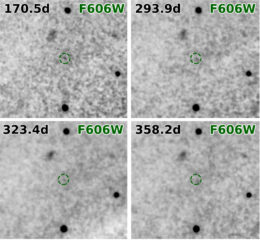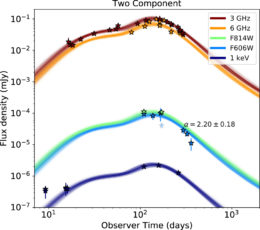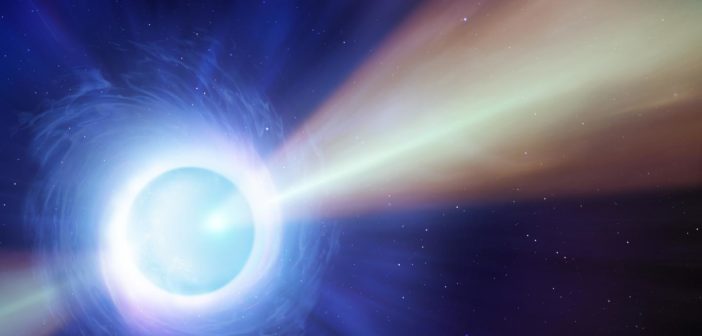When two neutron stars merged in August of 2017, telescopes around the world watched the fireworks that came next. But it’s not just the seconds and minutes after merger that can teach us about what happened! Hubble observations of the afterglow a year later are now providing new clues.
A Wealth of Observations

Late-time Hubble observations of GW170817 spanning 170 days to 358 days after the merger. [Adapted from Lamb et al. 2019]
Two leading questions we hoped GW170817 would answer were how matter is expelled during the sudden explosion of energy when neutron stars collide, and what the environment around the colliding stars is like. Now, a team of scientists led by Gavin Lamb (University of Leicester) has used Hubble observations from a year post-merger to address these questions.

Model light curves fit to various observations of GW170817’s afterglow, spanning a year after merger. [Lamb et al. 2019]
Structuring a Jet
Two leading theories for the observed outflow from GW170817 are a jet-dominated model, in which a fast-moving jet punched through the surrounding material and carried away mass and energy, or a cocoon-dominated model, in which a jet tried to escape, but was instead choked by a surrounding cocoon of slow-moving material.
The authors’ analysis of the afterglow observed by Hubble indicates that a structured jet did, in fact, appear — an outcome that supports previous radio observations also favoring the jet-dominated model.
To better understand the structure of the jet, Lamb and collaborators model GW170817’s outflow in two ways:
- a two-component jet that consists of a very narrow (only ~5° wide), incredibly fast-moving core (flowing at nearly the speed of light!) surrounded by a slower-moving, slightly wider (~15°) cocoon of swept-up material; or
- a single-component jet with a smooth, Gaussian distribution of energy and no cocoon.
The authors find that both models well fit the afterglow observed by Hubble, though the single-component Gaussian model provides a slightly better fit at late times. Continued observations may help to distinguish between the models.
A Cluster Home?

Hubble image of the lenticular galaxy NGC 4993, host to GW170817 (shown over time in the zoomed insets]. Could GW170817 have been hosted in a star cluster within this galaxy? [NASA and ESA]
It’s possible that neutron-star mergers may occur in star clusters, as the high density of stars in clusters could lead to binary pairs. We’ve identified the host galaxy for GW170817, but we can’t directly tell whether the merger occurred within a star cluster in the galaxy.
Using the Hubble observations, however, the authors show that the brightness of any underlying host cluster would have to be extremely low — so low, in fact, that it would be dimmer than 99% of Local-Group globular clusters.
We can add these constraints to the pile of intriguing clues we continue to accumulate as we study this landmark event!
Citation
“The Optical Afterglow of GW170817 at One Year Post-Merger,” G. P. Lamb et al 2019 ApJL 870 L15. doi:10.3847/2041-8213/aaf96b


1 Comment
Pingback: AAS Nova – New